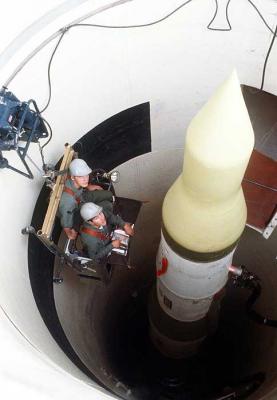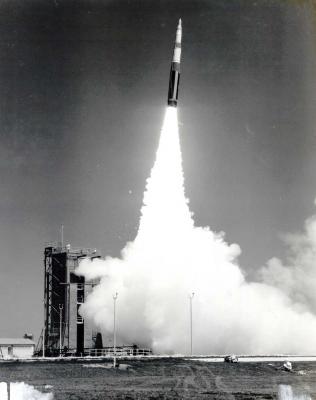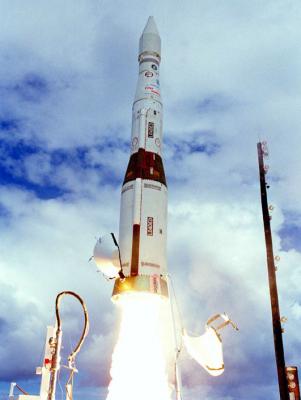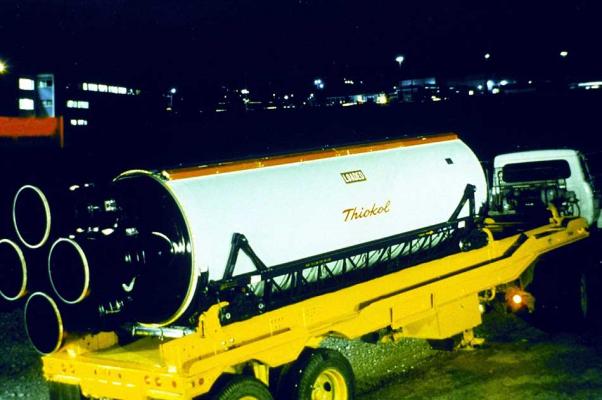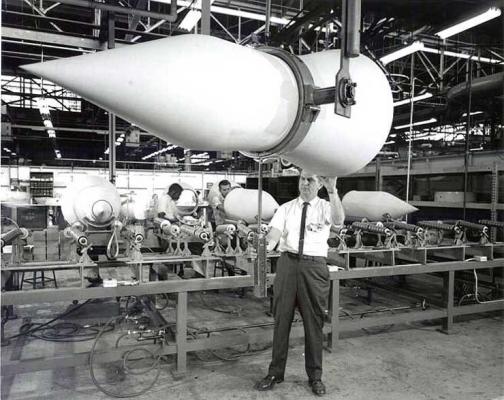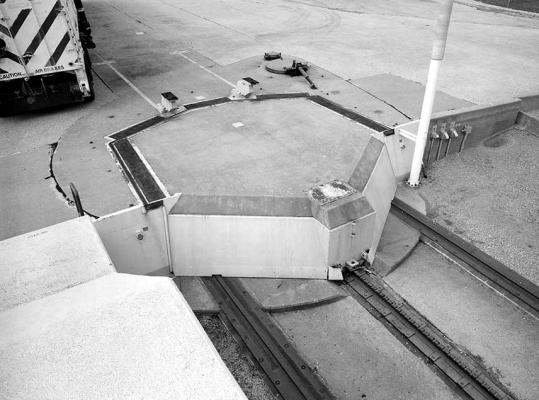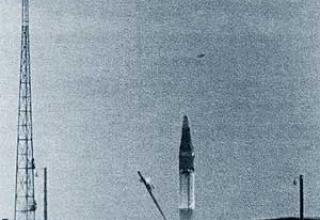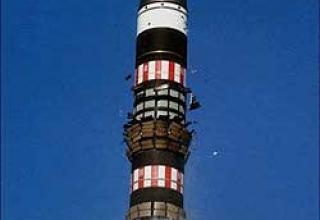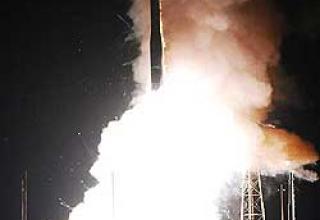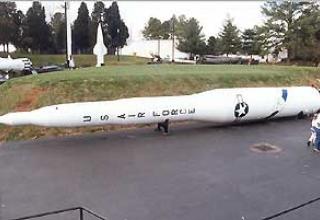Creation of the new ballistic missile, originally designated HSM-80F, began in March 1962, when the U.S. Air Force signed a contract with Boeing Corporation to develop a promising missile, which is a further development of the Minuteman-IB ICBM. The subcontractors of the contract were: Thiokol - development of the first march stage; Aerojet General - development of the second march stage; Hercules - development of the third march stage; Hercules and Atlantic Research - auxiliary RDTT; Autonetics - development of a control system and BCVM on the element base of development and production of Texas Instruments; AVCO - development of a combat unit; Tracor - development of a complex of means to overcome missile defense. The combat unit was traditionally developed, tested and manufactured by the laboratories and plants of the Atomic Energy Commission.
The requirements for the new ICBM, later designated LGM-30F and named "Minuteman-II", were detailed only in October 1963, when the General Headquarters of the Air Force issued Annex A to the General Operating Requirement 171 (GOR 171) of August 1958. The requirements included: an improved control system, increased range and weight-to-weight, and increased resistance of the complex to PNF. At the same time, back in June 1963. Strategic Air Command (SAK) of the Air Force issued a SOR (Specific Operational Requirement) for an ERCS (Emergency Rocket Communications System) command missile based on Minuteman ICBMs instead of MER-6A "Blue Scout Junior" missiles deployed in three position areas in the state of Nebraska. In November 1963, Defense Minister R. McNamara approved a program called "Minuteman Force Modernization Program" (MFMP), under which it was planned to completely replace all ICBMs "Minuteman-IA/B" with more advanced "Minuteman-II". In the same month, the decision to build a command missile based on the Minuteman-II ICBM was also approved.
In February 1964, the Ministry of Defense signed a contract for the construction of the sixth position area (Grand Forks Air Force Base, North Dakota) to house the first 150 Minuteman-II ICBMs. The mine launchers and command posts (CPs) of this position area, designed as the WS-133B weapon system, were to outperform all previously built complexes (WS-133A Block 0 and Block 1) in terms of their resistance to PFCs. The 321st strategic missile wing was deployed in the sixth position area. In January 1966, the first link of 10 new ICBMs began combat duty on the new equipment. In April 1966, the first unit of 10 new ICBMs began combat duty on new equipment. SAK formed 564th strategic missile squadron 341st strategic missile wing (base Air Force Malmstrom, Montana), which was the twentieth and the last squadron, equipped with ICBMs "Minuteman-II". In May of the same year, the MFMP program was launched at Whiteman Air Force Base, Missouri, where the 150 Minuteman-IB ICBMs of the 351st Strategic Missile Wing were to be replaced by the LGM-30F as soon as possible. However, after the installation of new missiles in the ICBM revealed the failures of onboard control system. The flow of such failures significantly increased and the only repair base at the Air Force Base Hill (Utah) could not cope with this amount of work. For this purpose, it was necessary to connect the capacity of the manufacturer of Autonetics, which immediately affected the rate of production of new missiles. The situation became even more complicated when the Minuteman-IB ICBM modernization program was launched. The reason for this phenomenon, which caused a delay in the deployment of the entire LGM-30F group, was the insufficient level of reliability of the control system, which was laid down at the stage of developing tactical and technical requirements. The flow of requests for repair could be coped with only by October 1967.
In January 1967, the LGM-30F was not able to cope with the flow of repair requests until October 1967. 321st strategic missile wing in its entirety went on combat duty. In December 1966, from the Air Force Base Vandenberg was first tested launch of ICBM "Minuteman-II" in the equipment of a command rocket. The launch was considered successful. The final third test launch of the command missile was conducted in April 1967.
In April 1967, Minuteman-II ICBM was first launched using the ALCS (Airborne Launch Control System) EC-135 "Looking Glass" air command post (see photo). The ALCS system was adopted in May of the same year and significantly increased the probability of commanding an ICBM launch in the event of an emergency. While in the normal situation 50 ICBMs of the missile squadron required coordinated calculations of two of the five squadron's ICBMs to be launched, the combined calculations of one IC and an EC-135 aircraft were sufficient with ALCS. During the following years of the Cold War, at least one EC-135 aircraft was constantly in the air in full readiness, while the maximum number of such aircraft in service with the SAC was reached in 1973 - 29 pieces. In 1990, all EC-135s were removed from permanent combat duty.
In October 1967, the Whiteman Air Force began the process of partial replacement of the LGM-30F ICBMs with a set of command missiles ERCS. As a rule, the number of deployed missiles in this configuration did not exceed 10. In February 1969, after the completion of the process of extracting from the mines of the base Air Force Malmstrom 150 and ICBM "Minuteman-IA" immediately began work on upgrading the control gear and controls for subsequent use of ICBM "Minuteman-II". The rearmament program was successfully completed in May of the same year. Thus, by June 1969 there were already 500 Minuteman-II ICBMs in service: 200 at Malmstrom Air Force base and 150 at Whiteman and Grand Forks Air Force bases. In addition, 500 Minuteman-IB ICBMs were deployed in three additional locations (Ellsworth, Minot and FE Warren Air Force bases).
The achievement of such a numerical ratio (coupled with the successful tests of the latest Minuteman-III ICBM with RFH IF) was not without reason evaluated as a success, so it was decided to slow down the Minuteman Force Modernization Program (MFMP) and change its essence. It was now planned to replace the remaining Minuteman-IB missiles (and some of the Minuteman-II missiles) with the newest Minuteman-III ICBM, which allowed the total number of ICBMs deployed to be significantly increased without altering the strength of this national SNFC component at a relatively modest cost. It was also decided to abandon the "Hard Rock Silo Program", which had been under consideration since 1968 (construction of BWIs in hard rock). Instead, in 1970, within the framework of the general MFMP program, it was decided to upgrade the existing BCPs and controls (additional subprograms "Silo Upgrade"/"Hardness Modification"). Within the framework of these subprograms it was planned to equip all control panels with improved electronic equipment with increased resistance to fossil fuels, a new depreciation system and to modify the mine roof. The roof thickness was increased by 25cm and weighed by 20t using special heavy reinforced concrete with high boron content. A special system of protection of electrical equipment against electromagnetic pulse of nuclear explosion was introduced by means of self-locking relays, electronic filters and dischargers for protection against spark overvoltages. The filtration and ventilation system was modified. It was also planned to equip the KP with advanced electronic equipment more resistant to PFN and a special system of protection of electrical equipment against EMI Java. The WS-133A Block 0 and Block 1 ground systems modified in this way received the designations WS-133A-M Block 0 and Block 1, respectively (WS-133B system did not change the designation). Later it was also decided to implement the "Command Data Buffer (CDB)/Improved Launch Control System" subroutines to provide centralized remote redirection of ICBMs standing in the ICBM. In addition, the new hardware was to reduce the probability of unauthorized missile launches. The mentioned programs were implemented in full by January 1980 on all Minuteman ICBM bases, except for Ellsworth base - on the Sputnik and KP of this base due to financial reasons it was decided to refuse from modification of the mine cover, new depreciation system for ICBM and CDB system.
In 1970, from the range at the Vandenberg Air Force base were carried out: the first combat training launch of the command missile "Minuteman-II" and the first simultaneous launch of two ICBM "Minuteman-II". In September 1974, the first training and combat launch of the Minuteman-II command missile and the first simultaneous launch of two Minuteman-II ICBMs were conducted on the Vandenberg Air Force base. The Air Force Headquarters approved the "Rivet Save Minuteman Modification Program", the goal of which was to reduce the number of combat crews of ICBM "Minuteman" from 3 to 2 people while reducing the duty period from 36 to 24 hours. In addition, the program installed new, more PFC-resistant KP equipment, which also reduces the probability of unauthorized missile launches by one member of the reduced crew. The program was completed by April 1978. In January 1975, the MFMP program was officially completed. A total of 550 Minuteman-III ICBMs (Malmstrom Air Force bases, Mainot, F.E. Warren, Grand Forks) and 450 Minuteman-II ICBMs (Malmstrom Air Force bases, Ellsworth, Whiteman) were deployed under the program.
The second half of the 70s was also marked by a rather intensive modernization process for LGM-30F missiles - production of the latest Minuteman-III missiles was discontinued in 1977, and the entry into service of the newest MX ICBM was delayed and it became clear that the LGM-30F ICBM would remain in service for quite a long time. In 1976, the program to study the impact of vibrations on the missile control system began. In 1979, an intensive program of modernization of the second march stage of the ICBM "Minuteman-II" - installed a new solid propellant, increasing the stability of individual components to the fossil fuel. In 1981 it was announced about the ARSIP (Accuracy, Reliability, Supportability Improvement Program) program to improve the accuracy, reliability and maintainability of the Minuteman-II ICBM. As part of this program, three special test launches of the Minuteman-II ICBM were conducted in 1982. The ARSIP program was completed in July 1987.
In November 1984 the ARSIP program was completed. In November 1984, 4 nuclear disarmament demonstrators broke into the roof of one of the SLBMs at Whiteman Air Force Base, causing $25,000 in damage to the launch complex. In March of the following year, all were sentenced to terms ranging from 8 to 18 years in prison. In April 1985, the Rivet MILE (Minuteman Integrated Life Extension) program was launched with the goal of improving the Minuteman control and control system. In 1987, the Rivet MILE program began installing the IMPSS (Improved Minuteman Physical Security System) at all launch sites. In 1989, a gradual replacement of ICBM stage transporters, ICBM stage installers in control panels, code entry verification equipment, emergency power batteries, etc. was started. The work on Rivet MILE program was completed by 1992... In the second half of the 80's all controls were modified in order to ensure the duty of crews consisting of women or mixed crews. Measures were taken to reduce noise at controls - according to American data, previously the average noise level at controls reached 70 dB (90 dB at maximum operating mode), which certainly tires the crews. The program of noise reduction allowed by installing special coatings inside the control and changing the algorithms of individual operations to reduce the severity of this problem.
By 1990 the treaty process between the USSR and the USA on nuclear arsenal reduction became intensive. It was decided to deploy 450 LGM-30F ICBMs as the "first casualties" in the U.S. category of ICBMs because, of all the deployed U.S. ICBMs, they had the lowest combat efficiency and were the oldest (in addition to 450 Minuteman-II ICBMs in three position areas, as of September 1990, another 24 ICBMs of this type were at the Hill Air Force (Utah) repair base and 18 were at the Oasis Air Force (Utah) storage base - a total of 492 ICBMs). The Americans managed to defend this point of view during the negotiations on the reduction of offensive weapons, which ended with the signing of the START-1 treaty in Moscow in July 1991. It should be noted that in this respect the Americans were undoubtedly helped by the political and economic difficulties in the USSR, due to which the collapse of the country had already begun to become irreversible. In September 1991, President J. Bush ordered all Minuteman-II ICBMs to be off permanent combat duty.
The last rocket "Minuteman-II" among those deployed at the base Ellsworth was removed from the mine in April 1994, and in July 44th missile wing deployed at this base, was disbanded. In May 1995, was removed from the mine last rocket LGM-30F on the base of Whiteman and 351st rocket wing was disbanded in July of the same year. Shooting controls and controls of these missile wings after the removal of all necessary equipment was rendered inoperable - Shooting controls were undermined with further sand and gravel, and the control room was poured concrete. Exceptions were made for one Ellsworth-based control and one Ellsworth-based control (there is a training ICBM in the mine) and one Whiteman-based control - they were turned into museums.
The SLBMs and controls of the 341st Missile Wing (Malmstrom Air Force Base) had a different fate - after the Minuteman-II rocket was recovered, it was modified under the Rivet ADD program for further use for Minuteman-III ICBMs. A total of 30 Minuteman-III ICBMs were installed between 1992 and 94, bringing the total number of such ICBMs in the four position areas to 530. In March 1995 it was announced that the missing 120 missiles to the full set will be transferred to Malmstrom base from Grand Forks, and the 321st missile group (including the 91st and 321st missile wings) will be disbanded. The last LGM-30F ICBM was taken out of the CPU in August 1995 (Malmstrom Air Force Base), after which this type of ICBM was officially retired.
At various times, the LGM-30F ICBM was actively used for experiments. In particular, in July 1966, the Minuteman-II ICBM was used to test the new Mk12 designed for the Minuteman-III ICBM. After decommissioning, the LGM-30F was actively used in the IFT (Integrated Flight Tests) launch program to test elements of the U.S. national missile defense system being created. The initial main contractor was the Lockheed Martin Corporation. The missile used (which was the second and third marching stages LGM-30F, control system and payload) was designated "Minuteman-II" MSLS (Multi-Service Launch System) and was used 8 times during the period from September 1996 to July 2001. The payload was a dilution stage, research design bureau and false targets of various shapes, weights and sizes (up to 8 pieces).
Besides, since May, 2000 under the given program the second conversion booster on the basis of "Minuteman-II", named "Minotaur-II", was also used. The main contractor is Orbital Sciences. Until December 2002, 5 launches were carried out. The payload was a dilution stage, research design bureau and false targets of various shapes, weights and sizes.
Composition:
The first stage of the LGM-30F missile consists of a Thiokol M55 RDT march and a tail compartment. The engine body of the first stage of the missile was made of pressed heat-treated steel sheets. Special steel of D6AC brand was used. The missile skirt, adapters and control system compartment had steel frame and aluminum cladding. The shell of the first stage of "Minuteman-II" rocket consisted of two sections obtained by successive rolling out of pressed steel billets. This method reduced steel consumption, reduced engine weight and increased strength due to lack of welds. The entire missile body was sprayed with Avcoat thermal protection coating, which consisted of epoxy resins and polyamide hardener. Four deflected nozzles were installed in the lower part, providing control of the traction vector during RDTT operation in the active section of the trajectory. Mixed fuel charge (TP-H1011/ TP-H1043 brand) is fastened to the casing.
The second stage (see photo) consisted of the Aerojet General SR19-AJ-1 marching engine and a connecting compartment. The RDTT casing was made of titanium alloy 6AL-4V. The use of ANB-3066 fuel based on polybutadiene allowed to get a higher specific impulse. Since the rocket engine had only one fixed nozzle, the developers had to use new ways to create control forces during its operation. Control of the thrust vector in the second stage of the second stage flight by pitch and yaw was carried out by injecting liquid freon into the critical part of the nozzle through four groups of holes located in the missile stabilization planes. To control the heel, an autonomous gas generator system with four fixed control nozzles mounted on the nozzle block was used. The second stage RDTT had a solid propellant charge of 6300 kg, which is about 30% more than that of the second stage "Minuteman-IB" marching engine.
The third stage (see photo) included RDTT Hercules M57 (solid fuel type - CYH & DDP), transition, instrument and connection compartments. The engine of the third stage had a body made of fiberglass plastic S-901 with high specific heat resistance. The inner surface of the case had a layer of heat protection made of rubber. The nozzle block is similar to the first stage. To reduce the weight of the structure, immediately after switching on the third stage engine unit, the tail compartment of this stage was reset. There were four holes in the RDTT body, covered with plugs (counter-retraction nozzles). They were opened at the command of the control system, which made it possible to vary the range of fire and provide braking of the stage during the separation of the combat unit (BC). Special compartments of the third stage accommodated elements of the Mk1A missile defense breakout system (BMD breakout system). The Mk1A anti-missile defense breakout system included nine containers of dipole reflectors, the third stage as a heavy false target and a modified ballistic missile defense system with reduced EPR. In order to ensure reliable third stage diversion from the detached booster and subsequent orientation for use as a heavy bogus target, the third stage was equipped with low-power auxiliary solid propellant engines: Hercules SR11-HP-1 diversion RTDT, Atlantic Research SR59-AR-1 diversion RTDT and Atlantic Research SR61-AR-1 roll.
See the photo of the LGM-30F Minuteman-II (before upgrade) missile without a head end.
The combat unit was equipped with a combat unit W56-4, which had increased power (2 Mt), resistance to foam and reliability in comparison with its predecessors of the same series. Two types of ICBMs were used for the LGM-30F - the Mk11B and the Mk11C. The latter, which has been in use since 1967, was characterized by increased resistance to PFCs, a somewhat reduced EPR, and the ability to use (with minimal changes) both conventional ballistic missile and HC command missile. The AB rate at entry into dense layers of the atmosphere is about 6800 m/s. The full flight time was approximately 34 minutes. The payload mass of the Minuteman-II rocket is 900 kg.
The LGM-30F missile was equipped with the NS17 inertial control system, which was the first in the world to be equipped with the D-37C. The element base of the NS17 control system was made entirely on the basis of so-called solid-state electronics. During the combat duty, all gyroscopes of the gyrostabilized platform's sensitive elements were rotated, which allowed the missile to be kept on high alert. The excess heat generated was removed by the temperature control system. The control system provided considerably higher accuracy of firing in comparison with its predecessor and possibility of quick reorientation (for the main mass of position areas). Prior to the CDB programme, the missiles were redirected by the service personnel by turning the missile to the required angle. For most of the position areas on the LGM-30F missile, remote control was used, allowing the platform to be properly turned with the missile without human intervention. When on duty, the control system was used for routine inspections and other operational tasks. The missile could be launched by one of eight flight tasks selected from a permanent SC memory immediately before launch.
Minuteman-II" missiles were placed in the mine launchers (MLRS) in 30-second readiness for launch. The launch was carried out directly from the mine after the first stage RDTT had entered the operational mode. Removal of the RDT from the control station was from 8 to 24 km. Each post had telephone and teletype (via HICS - Hardened Intersite Cable System, which was also used for launching missiles), low-frequency, high-frequency, ultra-high-frequency (satellite), etc. communication with the U.S. Air Force SAC Command Headquarters and, in addition, was connected with other squadron posts, which made it possible to launch missiles of the squadron at any two posts. To launch the missiles, four operators of the two posts were required to act in concert. For the WS-133B posts (the main contractor of the Sylvania communications system; for the WS-133A, Boeing), in addition to HICS, a system for the transmission of commands to the control panels in the medium frequency range was provided (according to crew feedback, this system was extremely susceptible to interference). The HICS system for WS-133B posts was simplified.
The combat positions were powered by local power plants, and in case of an emergency there were diesel generators at each mine (75kW) and control posts (100-150kW), which were switched on automatically. The combat positions in the position area were maintained by a central repair base, which was connected to all control posts. The repair base had spare parts for missiles and ground equipment and various vehicles from transporters and vehicles to airplanes and helicopters.
The missile launch site had a depth of 26-27m and a diameter of about 4m (see diagram). The shaft of the mine was made of reinforced concrete sections. ShPU was closed by a reinforced concrete slab, which was opened by hydraulic drives (in a critical situation - with the help of pyrotechnics). There was enough space between the rocket body and the walls of the shaft for exhaust gases, the temperature of which reached 2700°C. In the upper part of the mine shaft there was an amortized room for launch and inspection equipment (optical collimator for gyrostabilized platform alignment, control unit for control system operation verification and other equipment). The outer diameter of this room was 9m and its height 9.7m. In the shaft, the missile was held on a shock-absorbing ring, which was connected to the walls by three springs fixed in the walls of the barrel. The SPU protection was 70 kg/sq.cm. Each shaft was equipped with a triple alarm system.
Control posts (see diagram) were placed underground at a depth of 12.2-30.5m in steel chambers lined with concrete; the thickness of steel walls was at least 6.35mm, and concrete lining - at least 1.2m. On each subsequent system (WS-133A Block 0 >WS-133A Block 1>WS-133B) the degree of burial for control rooms and systems to provide control rooms and control loops was increased, additional methods of protection of main and auxiliary structures (underground, additional burial, encapsulation, etc.) were applied. The controls of WS-133B systems were much more spacious and comfortable, for which they earned the nickname Cadillac from the crews (see photo).
In 1965-1978 the standard combat crew of the "Minuteman-II" ICBM was composed of three men:
- MCCC - Missile Combat Crew Commander;
- AMCCC - Alternate Missile Combat Crew Commander is the reserve commander of the combat missile crew;
- DMCCC - Deputy Missile Combat Crew Commander - assistant to the commander of the combat missile crew.
Since 1979, the crews consisted of only two people - MCCC and DMCCC.
The missiles were delivered to combat positions in transport containers made of aluminium alloy (lid and stringers made of magnetic alloy), coated from inside with polyurethane foam insulation, on which two layers of polyester resin were applied and between them a gasket made of fiberglass. The container maintained the temperature of 18-36°C (at ambient temperature from -34 to +46°C) and relative humidity not exceeding 57%. The container was installed on a hoist conveyor consisting of a five-axle tractor and a three-axle trailer (see photo). The tractor has a hydraulic drive in the front part, by means of which the container with the rocket is lifted to an upright position when installed in the control panel (see photo). The missiles could also be transported by C-133B aircraft.
Characteristics:
| Range of fire, km | 11000-11500 |
| Number of rocket stages | 3 |
| The length of the rocket, m | 17,6 |
| Maximum housing diameter, m | 1,68 |
| Start weight, kg | 33700 |
| Circular deviation, km | 0.37-0.63 |
| Stage one: -length, m -diameter, m -kerb weight, kg -engine -height, kgf -fuel weight, kg -nozzle number |
7,29 1,68 23210 single-chamber RDTT Thiokol M55 90780 20690 4 |
| Stage two: -length, m -diameter, m -kerb weight, kg -engine -height, kgf -fuel weight, kg -nozzle number |
4,22 1,3 7280 single-chamber RDTT Aerojet General SR19-AJ-1 27500 6200 1 |
| Stage three: -length, m -diameter, m -kerb weight, kg -engine -height, kgf -fuel weight, kg -nozzle number |
2,08 0,95 2010 single-chamber RDTT Hercules M57 7750 1660 4 |
Testing:
Of the more than 50,000 launches of Milan missiles (training and combat missiles) carried out in various conditions, 92% ended in a direct hit. The effectiveness of the complex was demonstrated in combat conditions: Iraq since 1980, Syria and Great Britain in 1982, French troops in Lebanon in 1984, Chad in early 1987. With nine PU units of the Chadian land forces hit more than 100 tanks and other vehicles in Libya, using about 250 missiles "Milan-2".
Sources:
- To defend and deter: the legacy of the United States Cold War missile program / J.C. Lonnquest and D.F. Winkler. USACERL, 1997.
- From Snark to Peacekeeper: a pictorial history of Strategic Air Command missiles / SAC HQ Office of the Historian, 1990.
- Alert operations and the Strategic Air Command, 1957-1991 / SAC HQ Office of the Historian, 1991.
- Strategic Air Command and the Alert program: a brief history / SAC HQ Office of the Historian, 1988.
- US Strategic and Defensive missile systems 1950-2004 / M.A. Berhow and C. Taylor. Osprey Publishing Ltd., 2005.
- Minuteman Weapon System. History and Description / ICBM Prime Team TRW Systems, 2001.
- Malmstrom AFB: 1942-1992, 50th Anniversary, Great Falls, Montana / 341st SMW History Office, Malmstrom AFB, Montana, 1992
- А.А. Шумилин «Авиационно-космические системы США», 2005 Москва, «Вече»
- http://www.fas.org/nuke/guide/usa/icbm/lgm-30_2.htm
- http://www.arms.ru/nuclear/minute2.htm
- www.strategic-air-command.com
- www.astronautix.com
- www.nuclearweaponarchive.org
- www.globalsecurity.org
- www.af.mil
- www.defenseimagery.mil
- www.nps.gov
- www.aero.org

